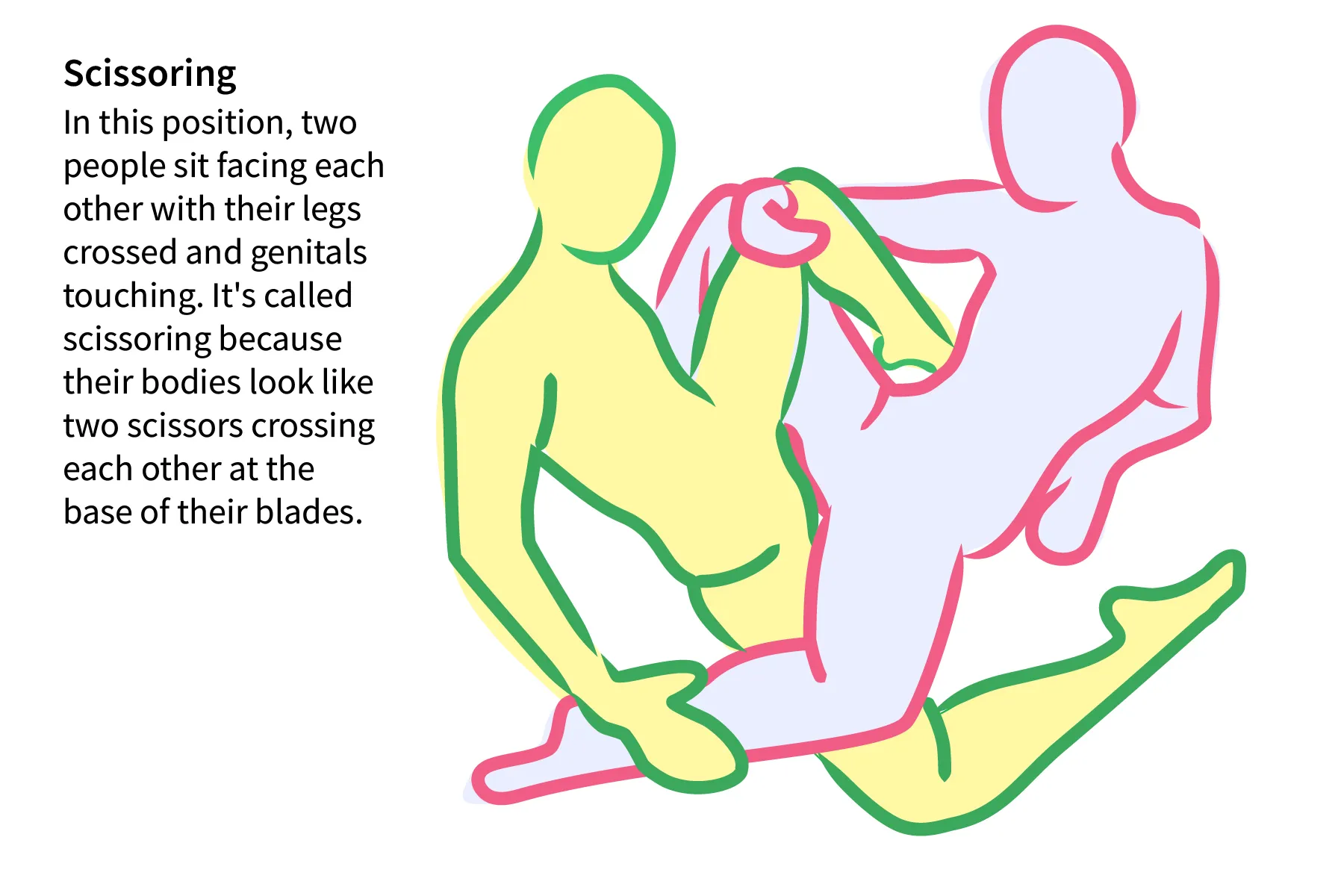Scissoring is a sexual position where two partners sit facing each other and cross their legs so that their genitals touch. It's called scissoring because the position looks like two scissors crossing each other and touching at the base where the blades meet, with each partner's legs imitating the blades.
Scissoring is also called tribbing. It's usually thought of as a sexual position for stimulating the clitorises of two people assigned female at birth. But anyone can do it, no matter their genitalia, gender identities, or sexual preferences.

How Does Scissoring Work?
In the classic scissoring position, each person spreads their legs and touches their genitals together. Usually, one person lies on their back, while the other person rests on their side. Then, they start to move their hips and rub their genitals together. There can also be penetration if one partner inserts their penis or a sex toy into their partner's vagina or anus. Vibrators can also be used for extra stimulation.
Upright scissoring is a variation of the classic position. One partner sits up and opens their legs while their partner lies down and slides their hips forward to make genital contact. Then, they rub their genitals together. The sitting partner has more control and stability in this position. They can adjust their body position to increase their pleasure.
What is the difference between scissoring and tribadism?
Tribadism, or tribbing, is the category the scissoring sex position falls under. Tribbing includes any position in which two people rub their genitals together. Scissoring is one specific way to do this with the legs crossing. But scissoring and tribbing are commonly used to mean the same thing. The definition of scissoring has become broader to include different genders and genitalia, so many positions now count as scissoring.
These positions are also often called tribbing or scissoring, although they don't involve the legs crossing:
Missionary scissor. In this version, one partner lies on their back with their legs apart. Their partner positions themselves in between their legs and touches their genitals against their partner's genitals.
Genitals to thighs. You don't have to touch genitals in this version of scissoring. One partner sits or lies down, and the other partner straddles their thighs. They can then rub and press their genitals against the partner's thigh for stimulation. You can also rub against your partner's hips, stomach, butt, or any other part of their body.
What Does Scissoring Feel Like?
Scissoring can be highly stimulating and sensual. The feeling of rubbing your genitals against your partner's is a totally different sensation from touching with your fingers or mouth. The friction between the genitals creates one kind of stimulation, and the humping or rubbing creates another type of stimulation. The movement and pressure can be adjusted in many ways to create different sensations. If you use sex toys at the same time, this can add to pleasure sensations.
What Are Some Myths About Scissoring?
The main myth about scissoring is that it can only happen between two women. But people of any gender can do it, and for people with penises, it can even include penetration. It is the act of rubbing the genitals together or against your partner's body part that makes it scissoring, not the sex of the partner.
Another myth is that you can't get a sexually transmitted disease (STD) from scissoring. Although scissoring might not involve penetration, you can still get an STD.
How Do You Stay Safe While Scissoring?
Using protection, such as a dental dam, can help lower the risk of getting an STD, but it can't prevent it. If you or your partner has a penis and there will be penetration, use a condom for STD protection and birth control. Use a condom over sex toys that will be inserted into your or your partner's body, and be sure to clean the toys well with soap and water afterward. The only way to fully protect yourself is to make sure you and your partner are in a monogamous relationship, get tested for STDs, and get screened to ensure that you are both free from such infections.
Scissoring can be physically tough, and not everyone will be able to safely or comfortably do it. It takes a moderate amount of physical fitness and uses muscles you might not normally use in your everyday life. Take it slow to lower your risk of getting a muscle injury.
Scissoring involves a lot of rubbing of your skin, hair, and genitals, which creates a lot of friction and could cause chafing. You can use lube to help your skin and genitals more easily rub against each other, and it can also boost pleasure sensations.
As with any sexual act, both partners must always be willing and interested. Make sure your partner gives their consent before scissoring.
Takeaways
Scissoring is a sexual position that involves rubbing your genitals against your partner's. It's also sometimes called tribbing. It can be a way for people of all gender identities to find pleasure without penetration or oral sex. It can be a pretty active position, so you'll need to have a moderate amount of physical fitness. You should also take steps to avoid getting an STD. And if there will be penetration, use a condom to avoid an unwanted pregnancy.
Scissoring FAQs
Is scissoring physically pleasurable or effective for orgasm?
Scissoring can be pleasurable for some people, but it all depends on what feels best for you and your partner. Discuss openly with your partner about what feels good, what doesn't, and what works for both of you.
How common is scissoring among lesbian or bisexual women?
Everyone's sexual preferences are different. Some couples may prefer scissoring (or tribbing), while others may prefer penetrative or oral sex or other types of intimacy.
Who commonly practices scissoring?
Anyone can practice scissoring with their partner, regardless of their gender identity, but it is most commonly linked to sex between women.


